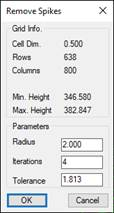5.10. Remove Spikes |
This command enables us to correct a mesh by changing vertices that create spikes in it. On executing the command, we will need to locate a mesh file and the following dialogue box will appear once it has been selected:

First of all, we will see the following for the purpose of reference: the size of the cell and the mesh and the range of elevations. The following three parameters can be adjusted to conduct this process:
Radius: Defines the maximum area occupied by the spike. In the case of spikes formed by a single vertex, a radius equivalent to the size of the cell will suffice, however in other cases it will need to be adjusted in accordance with the size of the area to be cleaned up. The program will suggest a size of four cells by default.
Iterations: The number of times the process is repeated. The removal process will always be repeated several times on the result of the previous iteration. As such, having previously corrected the mesh, the vertices detected as spikes will tend to further reduce the elevation, as each pass in their environment (in the case of spikes formed by more than one vertex) has changed the elevations. This parameter should be proportional to the radius to ensure the spike areas are cleaned up to the greatest extent possible. The program will propose four iterations by default.
Tolerance: Defines the minimum difference in elevation in order to regard a vertex as a spike, when comparing the elevation of the same with the elevations of its surroundings (delimited by the radius). By default, the program will propose that all elevations over 10% of the distance between the minimum elevation and the average elevation of the mesh are regarded as spikes.
On conclusion of the command, it will specify the number of vertices that have been changed (spikes removed) and will ask for the route of the resulting mesh file.
|
|